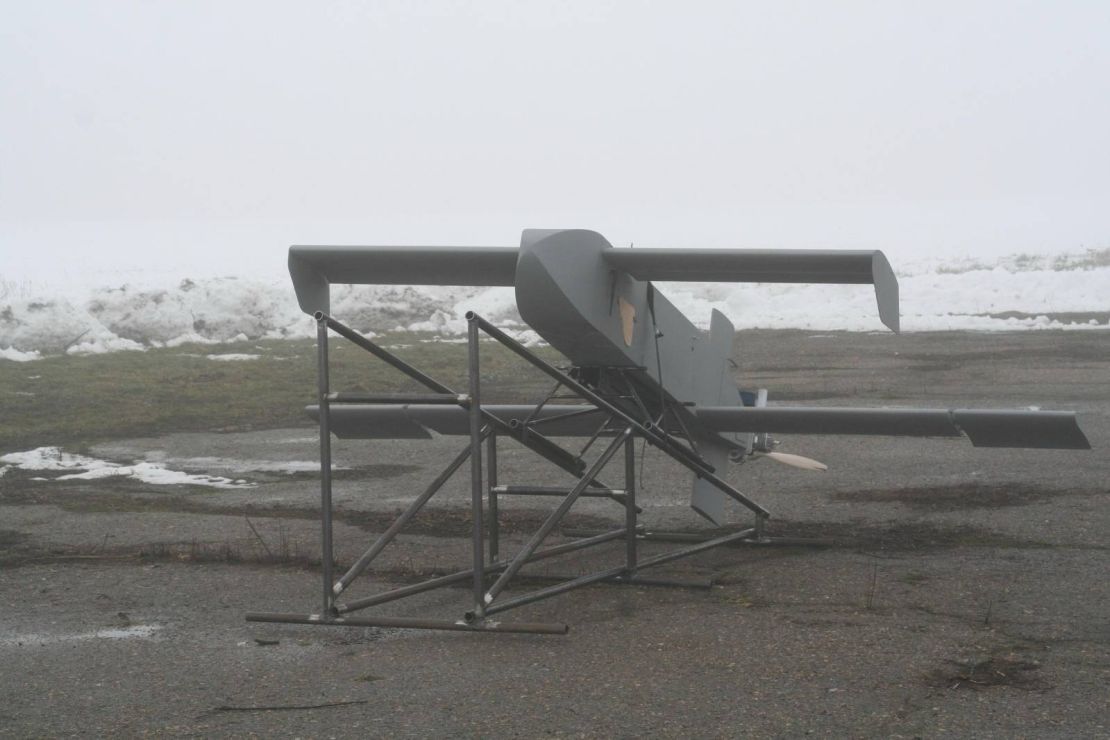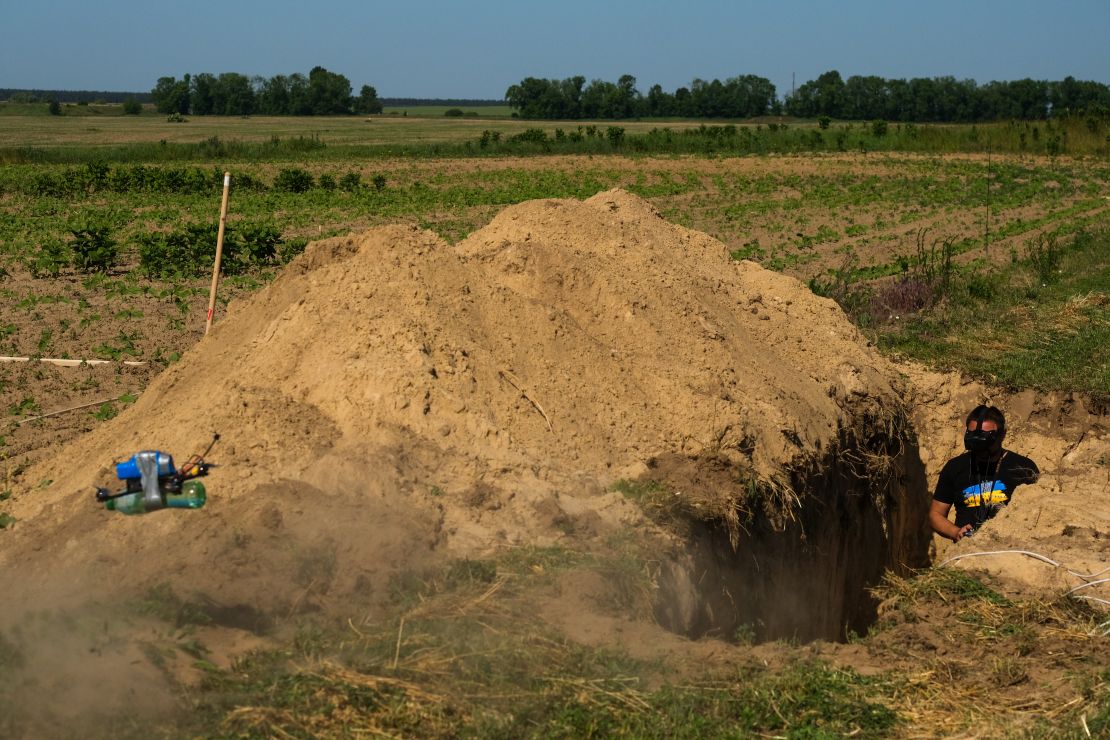There’s a loud buzzing sound as a small silhouette approaches in the air. The noise is eerily reminiscent of Russian drone strikes on Ukraine, but this episode was recorded closer to Moscow than to Kyiv.
“They’re flying right towards us,” a woman is heard saying in Russian, in a video shared on social media and reviewed by CNN. As the object comes closer, it becomes clear: This is a Ukrainian drone, flying over Russian territory. “I’m f**king scared,” she lets out.
Another video, recorded moments later, shows the same drone veering left as loud air raid sirens muffle the propeller’s noise. Seconds later, the drone dives from the sky, smashing into a pipe-covered tower at a Russian oil refinery, exploding on impact.
CNN geolocated the videos to Rosneft’s Ryazan refinery — one of Russia’s largest — more than 500 km (311 miles) away from Ukraine. The strike on March 13, one of several on this facility alone, was part of a concerted Ukrainian effort to target Russian oil refineries with long-range drones.
These daring Ukrainian strikes are hitting Russia’s massive oil and gas industry, which despite Western import bans and price caps has remained the biggest source of revenue for Moscow’s war economy.
The attacks have been made possible by the use of drones with longer ranges and more advanced capabilities, some of which have even begun to integrate a basic form of artificial intelligence to help them navigate and avoid being jammed, a source close to Ukraine’s drone program told CNN.
“Accuracy under jamming is enabled through the use of artificial intelligence. Each aircraft has a terminal computer with satellite and terrain data,” the source explained. “The flights are determined in advance with our allies, and the aircraft follow the flight plan to enable us to strike targets with meters of precision.”
That precision is made possible by the drone’s sensors.
“They have this thing called ‘machine vision,’ which is a form of AI. Basically you take a model and you have it on a chip and you train this model to identify geography and the target it is navigating to,” said Noah Sylvia, a research analyst at the Royal United Services Institute, a UK-based think tank. “When it is finally deployed, it is able to identify where it is.”
“It does not require any communication (with satellites), it is completely autonomous,” Sylvia added.
Chris Lincoln-Jones, a former British military officer and an expert in drone warfare and artificial intelligence, said the level of “intelligence” was still very low.
“This level of autonomy had not yet been seen in drones before, but we are still in the early stages of potential of this technology,” he told CNN.
CNN reached out to Ukrainian Defense Intelligence and the Security Service of Ukraine (SBU) but neither wanted to comment on the use of AI technology.
Ukraine’s use of drones is not new. The country has relied heavily on them since the beginning of Russia’s full-scale invasion on February 22, 2022, and has piled resources into advancing technology and domestic manufacturing.
At first, Kyiv was mostly using off-the-shelf equipment, either for surveillance or ingeniously adapted on the ground to drop small bombs. But it has since built a fully fledged drone industry, giving it a technological edge to set against Russia’s significantly larger manpower and better prepared industrial apparatus.
It also explains Kyiv’s increasing precision, visible in these attacks on refineries, where Ukrainian forces have made a point of targeting a specific area, maximizing the impact of these strikes.

Several experts contacted by CNN said that rather than hitting fuel storage facilities, for example, Ukraine was hitting distillation units, where crude oil is processed and turned into fuel or other derivatives.
“From what we’ve seen, some of it is they’re striking targets that need a lot of Western technology and Russia has a much more difficult time procuring this technology,” Sylvia said.
This approach gives Kyiv more bang for its buck, hurting more than just striking the refineries at random. And the markets are noticing.
“We really see this as a shift in Ukrainian tactics to try to defund the Russian war machine,” Helima Croft, a managing director and global head of commodity strategy at the investment bank RBC Capital Markets, said in an interview.
Experts believe these attacks could have a greater impact on the Russian economy than the current sanctions.
“If you think about the sanctions that have been put in place so far, they’ve largely bypassed energy,” Croft explained. “It really has been energy exports, crude, natural gas, refined products, that have given Russia the economic lifeline to continue to fight this war.”
Ukraine says 12% of Russian refining capacity is now offline, while Reuters calculates it’s up to 14%. Russia has admitted some of its refining capacity is down and has temporarily banned exports of gasoline to avoid an increase in domestic fuel prices.
“These weeks have demonstrated to many that the Russian war machine has vulnerabilities that we can reach with our weapons,” Ukrainian President Volodymyr Zelensky said this month after a string of these attacks.
“What our own drones are capable of is a true Ukrainian long-range capability. Ukraine will now always have a strike force in the sky.”
Ukrainian strikes on refineries have caused global oil prices to rise, with Brent crude up nearly 13% this year, leaving politicians in the United States worried about their potential economic impact in an important election year.
Though not mentioning energy prices, officials in Washington have said they are actively discouraging Ukraine from striking these refineries. “We have long said that we do not encourage or enable attacks inside of Russia,” one official told CNN.
Croft said US and international sanctions imposed since the beginning of the war had been structured to keep Russian energy on the markets.
“That was the deal with Ukraine: We will give you money, we will give you weapons, but stay away from the export facility, stay away from Russian energy, because we don’t want a massive energy crisis,” Croft explained.

But the impasse in Washington over funding for Ukraine, and the potential for change in the White House next year, could give Kyiv some leeway.
“If they’re not getting the weapons and money that they were promised, what is their incentive to abide by that deal with Washington?” Croft said.
A bigger worry, experts say, is that Ukraine will not stop at refineries. Some of Russia’s biggest oil ports, responsible for about two-thirds of its crude oil and oil product exports, according to RBC, are in range of Ukraine’s drones.
“If we simply had one major export facility hit, I think the impact on markets would be substantial,” Croft said. “Many of these export facilities are adjacent to the refineries and, for now, it looks like a deliberate targeting choice to go after refineries.”
Ukrainian officials have acknowledged US concerns but say the strikes will continue.
“It is clear that we have to minimize these budget revenues as much as possible and automatically cut off Mr. Putler’s oxygen,” said Vasyl Maliuk, the head of the SBU, using a combination of Putin and Hitler’s name common in Ukraine.
“So we will continue to work, while the gas station country continues to burn,” he added.













